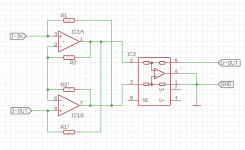In this thread I presented my development of a balanced input phono stage.
I call the actual board experimental phono preamp, because it offers the possibility
to rewire the input to the version I’m going to explain next…
I first saw this circuit in the german textbook Tietze/Schenk: Halbleiter-Schaltungstechnik and it looks like this:

In the book it is described as a floating ampere meter with low voltage drop. At first glance the circuit looks a bit confusing.
For the condition R1=R1’ and R2=R2’ the same current that flows in one of the inputs,
comes out of the other input and each of the input op-amps puts out a corresponding voltage.
The voltages then were subtracted in IC2. Uout = (R1+R1’)*Iin
The point where R2 and R2’are tied together creates a virtual ground, which causes the difference between the two inputs to be null Volt.
So the performance of this circuit strongly depends on the matching of R1/R1’ and R2/R2’.
I found additional informations here:
EDN: Measure small currents without adding resistive insertion loss
and the circuit seems to go back on the US patent: US4242741 Floating shunt seismic amplifier
What do you think of it?
Cheers, Boris
I call the actual board experimental phono preamp, because it offers the possibility
to rewire the input to the version I’m going to explain next…
I first saw this circuit in the german textbook Tietze/Schenk: Halbleiter-Schaltungstechnik and it looks like this:
In the book it is described as a floating ampere meter with low voltage drop. At first glance the circuit looks a bit confusing.
For the condition R1=R1’ and R2=R2’ the same current that flows in one of the inputs,
comes out of the other input and each of the input op-amps puts out a corresponding voltage.
The voltages then were subtracted in IC2. Uout = (R1+R1’)*Iin
The point where R2 and R2’are tied together creates a virtual ground, which causes the difference between the two inputs to be null Volt.
So the performance of this circuit strongly depends on the matching of R1/R1’ and R2/R2’.
I found additional informations here:
EDN: Measure small currents without adding resistive insertion loss
and the circuit seems to go back on the US patent: US4242741 Floating shunt seismic amplifier
What do you think of it?
Cheers, Boris
Attachments
I've build an MM stage on similar principles after batting ideas around with people here. Yes the matching is a serious bind. I used the twisted pear retro lo-z circuit Retro - Balanced RIAA Stage mainly as I wanted to see if the board was suitable for the task for those who don't like vero.
Hans Polak has also done a design Designing a universal diff-in/diff-out Head Amp
Both the above are diff in diff out (which is what I want).
I will probably build Hans' circuit for an MC headamp one day.
Hans Polak has also done a design Designing a universal diff-in/diff-out Head Amp
Both the above are diff in diff out (which is what I want).
I will probably build Hans' circuit for an MC headamp one day.
Combining this input stage with the phono-pre-amp shown here:
Another balanced input phono-amp…
leads to a fully differential in + out transimpedance in + RIAA-conversion phono stage:

I think I will give it a try sometime...
Another balanced input phono-amp…
leads to a fully differential in + out transimpedance in + RIAA-conversion phono stage:
I think I will give it a try sometime...
That would work. I am tending to flat stages at the moment. Have a look at the twisted pear RIAA implementation as another way of approaching the problem. I'm tending to flat preamp designs with Digital RIAA so isolating the gain and the correction is the way I like to approach things.
Thanks for input. I’m still searching for an USB-audio interface to convert my records to digital, but I want to use my android tablet for it.
I don’t believe that there is any android software with which I could do the RIAA conversion… not to mention the computing capacity needed
I don’t believe that there is any android software with which I could do the RIAA conversion… not to mention the computing capacity needed
I've never looked seriously but then again I have miniDSP in my system, but its only two custom biquads so not a huge load.
You've reminded me, I have a boxfull of Maudio microtrackII with dead batteries. These were got in order to allow me to do ripping, but I only need one, so there will be spares once I've worked out how to bring them back to life.
You've reminded me, I have a boxfull of Maudio microtrackII with dead batteries. These were got in order to allow me to do ripping, but I only need one, so there will be spares once I've worked out how to bring them back to life.
- Status
- Not open for further replies.
